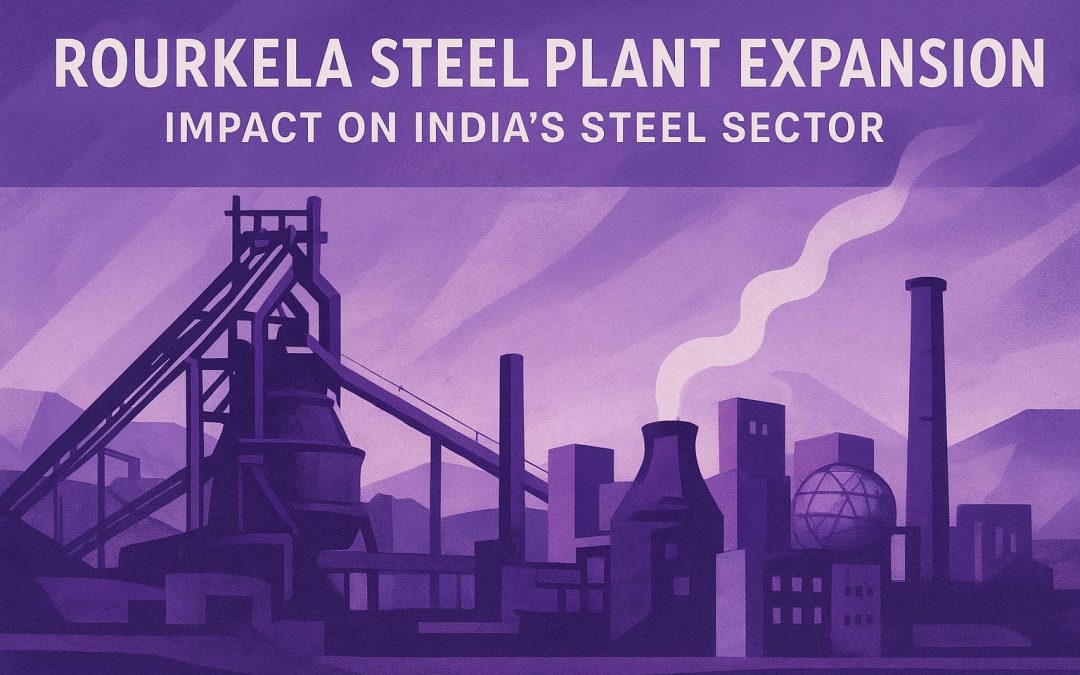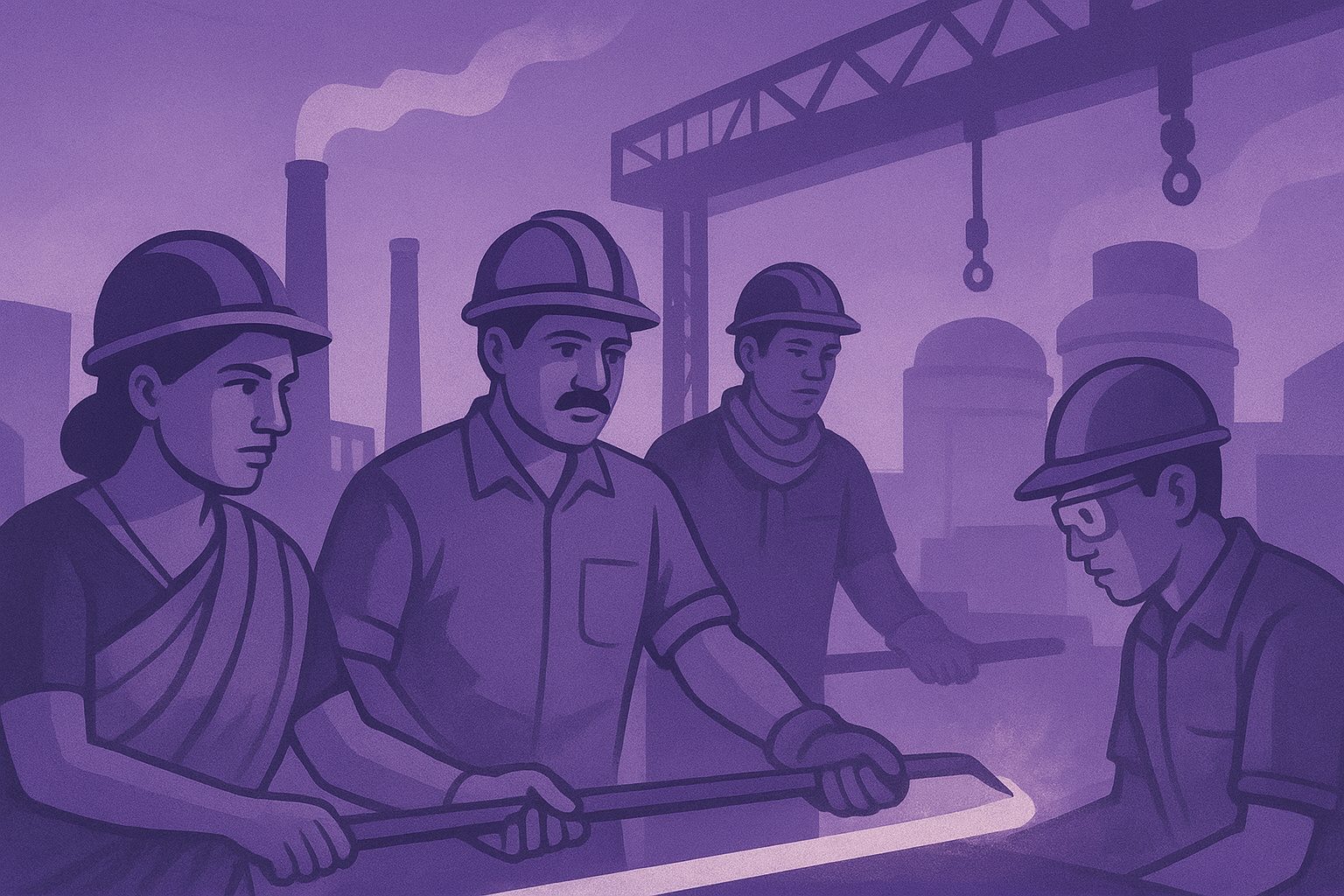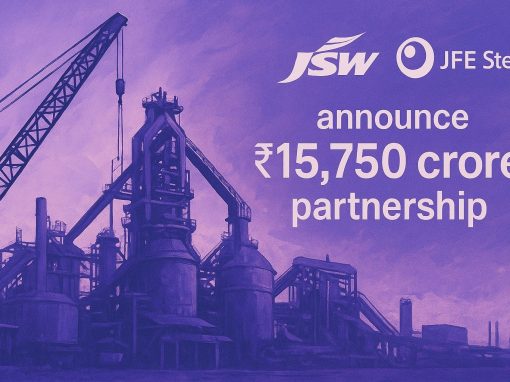Table of Contents
- Why Rourkela Steel Plant matters to India’s economy
- Details of the expansion
- Alignment with National Steel Vision 2030
- Economic impact on Odisha
- Relevance to MSMEs across India
- Impact on steel buyers, traders, and end-use industries
- Government–state coordination & policy environment
- Challenges and considerations
- Outlook for India’s steel sector
- Conclusion
The Union Minister for Steel and Heavy Industries, HD Kumaraswamy, announced a major Rs 39,000-crore expansion of the Rourkela Steel Plant (RSP) in Odisha. The plan includes a Rs 9,000-crore brownfield upgrade to improve existing facilities and a Rs 30,000-crore greenfield project to add new capacity. With this, RSP aims to increase its output from 4.5 million tonnes per annum to 9.8 million tonnes per annum.
RSP holds a strategic place in India’s steel network. It is the country’s first public-sector integrated steel plant and a major supplier to industries across eastern India. Its expansion strengthens the region’s industrial base and supports India’s wider development targets.
The project is closely linked to the government’s goal of raising national steel capacity from about 179 MT in FY24 to 300 MT by 2030. This increase is essential for large infrastructure programmes and rising domestic demand. This article looks at how the expansion will shape India’s steel sector, its economic impact, and why it is especially important for MSMEs and steel buyers across the country.
Why Rourkela Steel Plant matters to India’s economy
Rourkela Steel Plant (RSP) holds a special place in India’s industrial journey. Set up in the late 1950s, it became the country’s first public-sector integrated steel plant. Over the decades, it has helped shape India’s early industrialisation by supplying steel for bridges, railways, power projects, public works, and defence-linked needs.
Today, RSP operates with a capacity of 4.5 million tonnes per annum (MTPA). It produces a wide range of flat and long products used in construction, engineering, fabrication, automotive components, and infrastructure development. Its modern units also support the production of higher-quality and value-added steel grades.
RSP is a key anchor for the industrial belt of eastern India. Its presence supports a wide network of businesses and service providers in Odisha, Jharkhand, and neighbouring regions. This includes:
- Mining operations, especially iron ore from the Odisha Group of Mines.
- Logistics providers, including rail, road, and material-handling services.
- Fabrication and engineering units, which depend on steady steel supply.
- Local manufacturing hubs, producing machinery, structures, and components.
- MSME clusters, which rely on predictable raw material availability.
Together, these linkages make RSP a central driver of economic activity and regional development.
Details of the Rs 39,000-crore expansion plan
The expansion of the Rourkela Steel Plant (RSP) is designed to boost capacity, modernise operations, and prepare the plant for future steel demand. It combines brownfield upgrades with large greenfield additions, making it one of the biggest investments in the public steel sector.
Brownfield expansion (approx. Rs 9,000 crore)
The brownfield phase focuses on improving existing units and upgrading older systems.
- The plan includes modernisation of steel melting and rolling facilities.
- New technologies will improve energy efficiency, reduce emissions, and enhance operational stability.
- Upgrades aim to increase output consistency, lower downtime, and improve the overall quality of steel.
- These changes will help RSP produce more value-added products required by infrastructure, engineering, and fabrication sectors.
Greenfield expansion (approx. Rs 30,000 crore)
The greenfield project forms the largest share of the investment.
- It will add significant new capacity, allowing RSP to increase production from 4.5 MTPA to 9.8 MTPA.
- The expansion is expected to include new blast furnaces, steel melting shops, downstream mills, and support systems.
- Modern layout designs will improve material flow, energy use, and automation levels.
- With these facilities, RSP is likely to produce more high-quality and special steel grades, supporting India’s shift towards advanced manufacturing and infrastructure.
New facilities inaugurated
Several projects are already underway.
- A 1 MTPA Slab Caster at Steel Melting Shop-2 has been inaugurated, built with an investment of about Rs 1,100 crore.
- The minister also reviewed progress on Coke Oven Battery 7 and the new Pellet Plant, both key to improving raw material efficiency.
- These additions will strengthen RSP’s supply chain, increase productivity, and support the larger expansion target.
Strategic alignment with National Steel Capacity Vision 2030
| Key area | Explanation |
| National capacity target | The Government of India aims to increase steel capacity from about 179 MT in FY24 to 300 MT by 2030. This target supports rising domestic demand and major national development plans. |
| Role of Rourkela Steel Plant (RSP) | RSP’s expansion from 4.5 MTPA to 9.8 MTPA directly contributes to this national goal. It helps close the capacity gap and strengthens public-sector contribution to India’s steel output. |
| Fit Within National Steel Policy (NSP) goals | The NSP focuses on higher capacity, modern technology, energy efficiency, and production of high-quality steel. RSP’s upgrades and new facilities align with these priorities. |
| Support for infrastructure-led growth | The expansion will help supply steel for programmes such as the National Infrastructure Pipeline (NIP), Smart Cities Mission, housing projects, highways, railways, and renewable energy installations. |
| Boost to public-sector strength | Public-sector steel plants act as stabilisers during supply disruptions. Strengthening RSP ensures India has reliable domestic production even when global markets face volatility. |
| Strategic importance during global Uuncertainty | Global steel prices and supply chains remain unpredictable. Higher domestic capacity allows India to reduce import dependence, control price shocks, and maintain steady access to key steel grades. |
Economic impact on Odisha: Jobs, industrialisation & local development
The expansion of the Rourkela Steel Plant (RSP) is expected to create a strong economic ripple effect across Odisha. The project will generate a large number of direct jobs in plant operations, construction, engineering, and maintenance. It will also support indirect employment in transport, services, supply chains, and local businesses that depend on the steel ecosystem.
Local MSMEs stand to benefit the most. The growth of RSP opens new opportunities for:
- Fabrication units, supplying structures, components, and assemblies
- Engineering service providers, including EPC contractors and design firms
- Raw material handling firms, such as logistics and storage operators
- Ancillary manufacturers, producing equipment, spare parts, and safety systems
Mining activity will also see a boost. The Odisha Group of Mines has already increased output by over 5% this year and is expected to reach around 15 million tonnes in FY26. This ensures a stronger raw material pipeline for the expanded plant.
As capacity rises, Rourkela could evolve into a much larger industrial hub. New businesses, warehouses, workshops, and service clusters are likely to develop around the plant. Community development will also grow through improved infrastructure, training programmes, social projects, and higher local income levels. The expansion positions Odisha for long-term, stable industrial progress.
Why this expansion matters to MSMEs across India
Better access to raw materials
The expansion of the Rourkela Steel Plant increases domestic steel availability, which is crucial for MSMEs that rely on consistent raw material supply. With higher output, MSMEs can access the steel grades they need more easily, including flat products and special steels. This reduces dependence on imports, lowers uncertainty, and supports smoother production planning.
Potential stabilisation of steel prices
A rise in domestic capacity helps balance supply with growing demand. More supply in the market can reduce price swings, which often affect MSME margins. Stable steel prices allow small manufacturers, fabricators, and construction contractors to quote better, manage costs, and remain competitive.
Improved lead times & logistics
Modernised and expanded facilities reduce production and delivery delays. MSMEs benefit from faster processing, quicker dispatches, and shorter waiting periods for key products. This helps them run their operations on time, maintain inventory more efficiently, and meet customer deadlines with greater confidence.
Opportunities for vendor ecosystems
The expansion creates new business opportunities for MSMEs. These include services in maintenance, fabrication, components, safety gear, machinery parts, logistics, and sub-contracting for EPC projects. As Rourkela Steel Plant grows, its vendor base will also expand, giving MSMEs a chance to scale, diversify, and integrate into a larger industrial ecosystem.
Impact on steel buyers, traders & end-use industries
Stronger and more reliable steel supply chain
Doubling Rourkela Steel Plant’s capacity strengthens India’s domestic steel network. A higher output reduces pressure on the supply chain and makes it easier for buyers and traders to access material without long waiting periods. This supports steady operations across multiple industries that rely on predictable steel availability.
Benefits for key end-use sectors
Sectors such as construction, engineering goods, auto components, infrastructure, railways, and capital goods stand to gain. These industries depend heavily on timely supply of flat and long steel products. With additional production coming from Rourkela Steel Plant, project delays can reduce, and planning becomes more dependable for large contractors and manufacturers.
More value-added and specialty steels
The expansion allows Rourkela Steel Plant to produce higher-quality and value-added steel grades. This is important for modern applications, including equipment manufacturing, machinery, transport systems, and precision engineering. Buyers will have easier access to advanced steel varieties that previously needed to be imported.
Support for export competitiveness
Higher domestic production strengthens India’s ability to serve export markets. Large buyers and distributors benefit from improved availability, reduced bottlenecks, and more consistent supply. Over time, this can ease shortages, stabilise inventories, and help Indian products compete better globally.
Government–state coordination & policy environment
- Centre–state collaboration: The Central Steel Ministry and Odisha Government are coordinating closely to ensure smooth expansion, faster decision-making, and timely project support.
- Ease of doing business: Reforms include simplified land acquisition, quicker environmental clearances, and streamlined approvals for industrial projects.
- Logistics improvements: Enhanced road, rail, and port connectivity will support the expanded plant and improve supply chain efficiency.
- Alignment with national policies: The expansion aligns with Make in India and the Production-Linked Incentive (PLI) scheme for speciality steel, promoting domestic manufacturing and high-value steel production.
- Policy stability: Long-gestation steel projects need predictable policies to manage investment risks, maintain timelines, and attract industry partners.
This coordinated policy environment is crucial for ensuring that the Rourkela Steel Plant expansion meets its production goals and supports broader national steel capacity objectives.
Challenges and considerations
| Challenge | Explanation |
| Environmental approvals & sustainability | Large-scale steel projects must comply with strict environmental norms. Obtaining approvals and ensuring sustainable operations is essential to minimise ecological impact. |
| Raw material security | Continuous supply of iron ore and coking coal is critical. Any disruption can delay production and affect cost efficiency. |
| Infrastructure demands | Expanding capacity requires reliable power, water, and transport links. Delays or shortages in infrastructure can slow down operations. |
| Timely execution & cost control | Managing large projects involves strict timelines and budgets. Effective project management is necessary to prevent cost overruns and delays. |
| Global market volatility | Steel prices and demand can fluctuate internationally. These changes affect export competitiveness and domestic pricing stability. |
The table highlights the key risks that RSP and policymakers must address to ensure the expansion achieves its intended capacity and economic benefits.
Outlook: What the expansion means for India’s steel sector
The Rourkela Steel Plant’s expansion is set to play a pivotal role in India’s ambition to become a global steel leader. The increased capacity will strengthen the country’s industrial backbone and support large-scale infrastructure development. Key implications include:
- Support for National Steel Leadership: RSP’s growth contributes directly to India’s goal of reaching 300 MT steel capacity by 2030.
- Infrastructure growth: Higher steel output will supply projects under the National Infrastructure Pipeline, Smart Cities, highways, railways, and renewable energy sectors.
- Rising steel consumption: With more domestic production, per capita steel consumption in India is expected to grow, reflecting stronger industrial and urban development.
- Project timeline: While some facilities like the 1 MTPA Slab Caster are already operational, full capacity is expected to come online in phases over the next few years, ensuring a gradual but steady contribution to national steel output.
The expansion positions India to meet rising domestic demand while enhancing its global competitiveness in steel production.
Conclusion
The Rs 39,000-crore expansion of the Rourkela Steel Plant marks a major milestone for India’s steel industry. It will more than double the plant’s capacity, generating jobs, boosting local MSMEs, and strengthening Odisha’s industrial ecosystem. For steel buyers and end-use industries, the project promises steadier supply, improved access to high-quality steel, and more predictable pricing. Beyond regional benefits, the expansion is a critical step towards achieving India’s national goal of 300 MT steel capacity by 2030, reinforcing the country’s position as a global steel leader and supporting long-term infrastructure growth.
Looking to procure steel?
Tata nexarc helps manufacturers, builders and MSMEs source certified steel products, compare prices, and choose the right grade as per IS codes—with complete traceability and procurement confidence.
FAQs
What is the total investment for the Rourkela Steel Plant expansion?
What is the current and future capacity of the Rourkela Steel Plant?
What is the difference between brownfield and greenfield expansion?
Why is Rourkela Steel Plant strategically important for India’s steel industry?
How does the expansion support national steel goals?
What benefits does the expansion offer MSMEs?
How will steel buyers and traders benefit?
What new facilities are already operational?
What are the main challenges for the expansion?
When is the full expanded capacity expected to be operational?
A product manager with a writer's heart, Anirban leverages his 6 years of experience to empower MSMEs in the business and technology sectors. His time at Tata nexarc honed his skills in crafting informative content tailored to MSME needs. Whether wielding words for business or developing innovative products for both Tata Nexarc and MSMEs, his passion for clear communication and a deep understanding of their challenges shine through.








